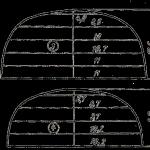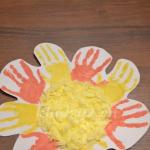DIY vase, decoupage of glass and ceramic vase. DIY vase decoupage Beautiful vase decoupage
Master class on making a vase using decoupage technique
Pavlukhina Vera Aleksandrovna, teacher additional education MAOU DO Youth Center "Zvezdochka" Tomsk
Target: mastering the depupage technique using the example of decorating a glass product.
Tasks:
- convey your experience through direct and commented demonstration of consistent activities;
- teach the skills of broadcast actions and techniques, ways to achieve the desired result;
- increase the motivation of participants Master Class and to create your own new style of creative activity;
Description: Due to its simplicity, this master class is accessible to anyone who is interested in mastering this technique. younger schoolchildren, and more adults. Everyone can feel like a creator and an artist; it is in the depupage technique that the basis is taken finished product, all you have to do is create your own style by imagining it, realizing your ideas.
Safety precautions when working with liquid substances (varnishes, paints, glue)
Before starting work, make sure that the containers containing varnishes, paints or glue are in good condition.
It is recommended to work in a ventilated area
It is advisable to use personal protective equipment when working with varnishes.
Cover the table with oilcloth
Avoid getting glue or varnish into your eyes, mouth, or nasal mucous membranes.
When working with hand glue, use wet wipes,
If glue gets into your eyes, rinse them with water.
Be attentive while working, do not get distracted
Use liquid substances (varnishes, glue, paints) only strictly for their intended purpose.
At the end of the work, close liquid substances (varnishes, glue, paints) tightly, rinse the brushes, and ventilate the room.
From the history of decoupage
The word "decoupage" comes from the French verb decouper ("to cut").
The history of this technology goes back to the distant past. Back in the 12th century, oriental craftsmen manually created thin paper with various images, which was used to decorate furniture, walls, household appliances. Covered with varnish, these drawings created the illusion of artistic painting.

Screen. China 13th century

Chest of drawers XV century
Soon this fashion smoothly flowed to Europe. Original, exquisite products made using this technique gave a certain exclusivity to luxury items. Unlike true works of art, they were much cheaper and were not inferior in quality to the original samples. Over time, the technique of cutting and pasting designs was transferred to other household items - vases, boxes, lamps and much more. People of different classes were happy to engage in such creativity.
Nowadays, this type of creativity is very popular.
Everyone's favorite holiday is approaching, which means it's time to gather interesting ideas. Have you already thought about New Year's decor your home? I invite everyone to create a fabulous environment together using bright decorations made with your own hands.
The year of the Fire Rooster is coming, so I advise you to meet and appease this bird with bright, original, beautiful decor so that he brings happiness to your home and does not leave it throughout 2017.
I propose to start decorating the vase.
Necessary materials:
- glass vase
- paint-primer (acrylic, universal)
- paper napkins
- scissors
- glue for decoupage (PVA is possible)
- synthetic brushes
- sponge or sponge
- acrylic paints
- acrylic lacquer
- semolina

Using a brush, prime the surface of the vase with primer paint and leave to dry (this “procedure” must be repeated 2-3 times).

We select the fragment we need on a napkin and carefully cut it out. Separate the two lower layers, leaving only the top layer with the pattern.



We attach the drawing to the vase and determine the place where our fragment will be located.
Using a brush and glue, glue our picture on top of the picture from the middle to the edges onto the dried, primed surface of the vase (carefully smoothing out the folds and bubbles with a brush).



Leave the vase until completely dry.

Using a sponge (a piece of sponge) using the “poke” method, we decorate the entire outer surface with white paint (matching color), slightly extending to the edges of the picture (for realism). Add a little blue tint.



We “live” our picture and leave it until dry.
Apply varnish on top with a brush.

After 1 hour, apply another thick layer of varnish.
After the varnish has dried, you can decorate the vase with semolina. Apply decoupage glue only to the area where there is no picture, and sprinkle with semolina.


The vase is ready.

Such a vase will become beautiful decoration and will bring comfort and coziness to your interior, and without a doubt it can become a good gift on the eve of the New Year holiday.
One of the most interesting creative activities is decorating various objects or, in other words, decoupage. This technique is simple and brings a lot of positive emotions. A simple and convenient item for decoupage is a vase. There are many ways to decorate, you only need desire and imagination. The glass of vases and vases can be decorated with images of flowers, made into an antique design, or made into a textured decoration.
Decoupage glass vase with napkins
Materials:
- glass vase;
- glue intended for decoupage;
- brush;
- rice paper;
- a napkin with a beautiful pattern;
- acrylic paint;
- acrylic varnish (aerosol);
- scissors;
- alcohol;
- sponge;
- cotton pad.
Decoupage vase with napkins:
- Wipe the vessel with a cotton pad soaked in alcohol.
- Tear the rice paper into small pieces and cover the vessel with them using decoupage glue.
- Wait until the paper dries. Soak a sponge in acrylic paint. Paint the vessel from bottom to top, creating a transition from pale yellow to white. Let dry.
- Cut out the necessary designs and patterns from the prepared napkin. Stick them on the product. Make a certain composition.
- Apply the first coat of varnish. Let it dry and then smooth out any imperfections using fine-grained sandpaper.
- Apply a second coat of varnish.
Decorating a glass vase with your own hands is complete!
Gallery: decoupage of glass and ceramic vases (25 photos)





























Decoupage ceramic vase
Materials:

Decoupage vase: Master Class. Execution stages.
- Cut out a flower design from a napkin. Remove the top layer from the napkin, and then remove the bottom layer without images.
- Place the flower pattern in a container of water for a few seconds. The napkin should stretch, thereby ensuring smoother adhesion to the surface of the vessel.
- Place the wet design with the back side up on the file and coat it with decoupage glue using a brush.
- Place the floral motif together with the file on the vessel, then carefully remove the file.
- Smooth out the edges of the picture. To do this, you need to slightly lift it and press it from the center to the edge.
- Align the existing folds with a brush with decoupage glue applied to it.
- Apply the first layer of acrylic varnish to the vessel. Wait until completely dry and apply another coat of varnish.
Decorating a vase with your own hands is completed!
Decoupage is also practiced in the virtual world, in particular, in the game of avatars. To pass the stage you need to make a vase with yellow flower. In the avatar, this task causes difficulties for some people. In order to complete it you need patience and perseverance. Due to the fact that when making a vase in the workshop, the color drops out automatically, you should craft them until the product with a yellow flower drops out.
Decoupage of kitchen utensils: master class
Decoupage of kitchen utensils is also quite a popular activity. Decorate plates, glasses, cutting boards, bread bins and other items in different styles. Let's look at some ways to decorate glasses.

Making a vase with your own hands: master class
It happens that you don’t have a vase at hand, but you really want to get creative. In this case, you can do it yourself.
Vase made of napkins
Materials:
- balloon;
- threads;
- paper napkins;
- glue;
- decoupage napkins;
- needle;
- decoupage varnish.
Stages.
- The product will have round shape. Inflate the ball.
- We thread the tip of the thread into the needle and wrap the ball, having first passed the threads through the glue. We start the winding from a wide place, and leave a hole at the top.
- While the glue is not dry, take paper napkins and place them on the ball, then wrap them with threads.
- We decorate the vessel with decoupage napkins.
- Cover with varnish.
- Remove the tie that holds back the air and carefully remove the ball.
The napkin vase is ready!
Floor vase
Materials:

Stages.
- We coat the vessel with glue and wrap it tightly enough with twine in one layer. We are waiting for it to dry.
- We make flowers for decoration. To do this, place cling film on the bottle. We form a petal across the bottle on the film using twine coated with glue. At the same time creating an elongated drop. We take a little longer string and coat it with glue. We wrap it around the first drop along the outside, pressing the threads tightly against each other. With each layer of string the petal will increase in size. Having reached the desired petal size, you need to stop and wait for the product to dry. Unfasten from the bottle. We make five more such petals.
- Glue the resulting petals to the vessel, and place a large rhinestone or button in the center of the flower.
The floor vase is ready!
Beautifully decorated items will bring a lot of aesthetic pleasure and comfort to life. How to decorate a vase using decoupage technique - watch the tutorial video.
The French word "decoupage" means "to cut out." The origins of beautiful ancient technology go back to the Middle Ages. The first mentions are found in German manuscripts of the late 15th century, it was at this time that furniture began to be decorated with carved decorative pictures. The technique gained its greatest popularity in the 17th century, when elegant objects brought from the East began to appear in Europe. Society ladies appreciated the cute little things and enjoyed using them beautiful vases, decorated with pebbles, tights and lace to decorate fashionable European salons.
Today ancient technology decorating various items is again at the peak of popularity. The ease and simplicity of the process allows even a novice designer to create unique works of art with his own hands.
For those who have decided to take up needlework for the first time, there is no need to buy expensive materials; it is better to purchase the necessary items in a regular stationery department.

For the upcoming decoration you will need:
- Brushes with soft bristles. Need different sizes;
- Small bowl. A utensil is needed for soaking napkins or rice paper;
- PVA glue. You can use regular stationery;
- Quick drying varnish. The varnish should be acrylic or polyurethane based;
- Cloth napkin or roller. It is more convenient to smooth out the formed wrinkles with a roller.
And, of course, the main item will be the product on which the decor is applied. This could be a vase, a bottle, a set of jars for bulk items.
After this, decorative materials for decoration are collected:
- An artistic image plus applied to a paper base.
- Stencils with geometry, floral or plant patterns.
- Acrylic or stained glass paints for applying the main background.
- Shiny beads, gold thread, rhinestones of different colors or eggshells.
Buy stationery items will not be difficult, but choosing the decor may take some time, because it creative process and you need to prepare for it thoroughly.
Decoupage vase in shabby chic style
The decoupage technique in the shabby chic style has no restrictions on the choice of artistic compositions, colors or accessories. Transfer to a glass surface, possibly any pictures you like.

For this we use:
- Multilayer napkins. This is the most common option.
- Rice paper. Has a lot of advantages. Rice paper can be used to successfully decorate different areas and achieve a beautiful three-dimensional image.
- Photo printing. As an image, you can use photographs of famous personalities, for example, Charlie Chaplin or Marilyn Monroe. The product will be more individual and will become a great gift for New Year's holidays.
Before you start decorating a glass or wooden base, you need to decide what technique you need to use to decorate it. The process can be direct or reverse.
Advice! The drawings and photographs selected as the paper base must be printed on a printer using waterproof ink.
The direct technique in the shabby chic style is characterized by applying a decorative picture of a rose or a design with butterflies to the front surface, and reverse decoupage is done underneath it. It is important to consider that reverse decoupage is only possible on the most transparent glass surface.
The choice of method largely depends on how the decorated item will be used in the future. For example, to decorate Ikea tabletop or floor vases, it is better to choose direct application, but saucers must be decorated in the opposite way.
The photo selection features beautiful creations by skilled craftswomen, made in a beautiful marine style using shells and pebbles.
We conduct a master class on decoupage of a glass vase
A detailed master class and the video below will help novice decorators become familiar with the main stages of decorating ceramic products.

What should be done:
- We select the most convenient place for creativity and arrange the necessary tools in the most rational way.
- Carefully cut out the design you like from rice paper or a multi-layer napkin.
- On the glass, using a felt-tip pen, mark the places where it will be applied. beautiful pattern. Marks are necessary to quickly return slipped paper to the selected place.
- Soak the napkin in a bowl of warm water.
- Before applying the image, you need to clean and treat the area with PVA glue.
- Paper is quickly applied to the adhesive base and carefully straightened from the center to the edges with a soft roller or cloth napkins. Care should be taken to ensure that no unsightly folds or air bubbles remain on the surface.
- Another layer of glue is applied on top with smooth movements of the brush.
- We paint the background with multi-colored or plain acrylic paints.
- The dried layer of glue is varnished, and then the finished product must be placed in the oven and heated to 150 degrees.
No putties are used to process glass, because the smooth surfaces of the bottles provide excellent adhesion to the applied design.
Spectacular decoupage vase in vintage style
An excellent result can be achieved by artificially aging the surfaces. Such unusual technique called craquelure. After treatment with a special varnish or universal glue, the surface of the antique vase is covered with a web of tiny cracked lines. The paint composition must be applied to a still wet layer of paint. For products created using the craquelure technique, it is necessary to apply a background coating.

An interesting solution would be to use contrasting colors:
- First, the first layer is applied - primer;
- A special varnish or glue is applied to completely dry soil;
- Another layer of acrylic paint is quickly applied to the layer of craquelure varnish.
After the second layer of paint has completely dried, cracks appear on the surface to be decorated; their depth depends on the thickness of the applied layer of universal glue or craquelure agent.
Details: decoupage of a vase (video)
Today, there are a number of design options using the decoupage technique. a large number of. Ancient needlework allows you to bring to life your most unusual ideas, develop Creative skills and is a great pastime. In addition, with luxurious crafts you can not only decorate your home or apartment, but also please your friends and acquaintances. Beautiful pieces of art will become a real decoration of vintage or Provence style. A gift made with your own hands using the decoupage technique will delight true connoisseurs of luxurious exclusive items.
Decoupage on glass is a very simple and entertaining way to get a beautiful and exclusive decorative item, for example, a glass vase or plate. We will tell you how to do this (step by step) in our article.
Historical excursion
Many types of art using paper came to us from China. Decoupage was no exception. Elegant, picturesque glass and ceramic items brought from the East immediately won the favor and favor of the hostesses of the most fashionable European salons.
But they weren't cheap. Although the product was decorated with a fairly cheap material - rice paper, the need to cover the surface with several layers of strong-smelling varnish, which took weeks to dry, turned this type of craft into a purely professional occupation.
Today, with the availability of modern quick-drying products that do not emit toxic odors, the decoupage technique is finding more and more fans. This has turned into a real art of decorating interior items with your own hands: ceramics, glass.
What do we need for work?
If you are a novice designer, do not buy expensive decoupage kits - it is much cheaper and easier to assemble it yourself at any stationery store. So let's get started. To decorate a boring and inexpressive glass product with an interesting design or composition (and do it all with your own hands), you need to buy:
- brushes (preferably with soft bristles) of different sizes;
- a bowl (for softening napkins or rice paper in water);
- office glue (preferably PVA), which discolors when dried;
- any quick-drying varnish based on acrylic or polyurethane;
- soft roller or cloth napkin for smoothing out wrinkles on the glass surface;
- and of course, the object being decorated: it could be a vase, plate, the decoration on the side looks very elegant candlesticks, ordinary glass bottles, etc.
Now we need to collect a set of “decorative” materials with which we will decorate our products:
- The main pictorial composition applied to a paper base: these could be, for example, napkins. If you are a creative person “to the tip of your tail,” you can draw a picture on rice paper with your own hands.
- Additional stencils with floral, floral or geometric patterns.
- Acrylic paints (stained glass paints are also suitable) - they are often used as a background or primer.
- Beads, sparkles, artificial stones For decoration.
In this list, only the first item is mandatory, but without additional decor (listed below), your hand-made masterpiece will not acquire completeness and integrity.
Image for decoration
The decoupage technique is captivating because there are restrictions on the choice of compositions, style and color scheme does not exist. You can transfer any image you like to the glass surface:
- One of the most common options is decoupage (multi-layer napkins).
- You can, as already mentioned, use rice paper. The advantages of working with this material are many. It allows you to play with areas that are more saturated in color and dense in texture and translucent areas in one composition, achieving three-dimensionality in the image. But even for beginners, using rice paper will make the work much easier: it does not require pre-processing (thinning) before application.
- Photographs can be used as decoration - in this case vase or the plate will acquire more “individual” features. This is a great idea for a holiday and a way to do something nice and please a loved one.
Advice! If you do not use a ready-made image (napkins, decoupage cards), print the selected drawings or photographs on a printer with waterproof ink.
Execution techniques
Before you begin describing the decoration (step by step), you need to decide which technique will suit you in this case. It can be direct or reverse.
The direct technique is characterized by drawing on surface, and reverse decoupage on glass - under her. Naturally, with this method of decoration we are talking only about transparent glass products.
The use of one method or another largely depends on the functional use of the item. For example, a vase is more susceptible to the “aggressive” effects of moisture from the inside, so it is more appropriate for it to choose a direct application of the image. Plates should be decorated with reverse decoupage: food should not come into contact with varnished surfaces.
Work algorithm
Below are step-by-step instructions for beginners in decorating glass surfaces with their own hands.
- Choose workplace and lay out materials and tools.
- Cut out the image you like from rice paper (or napkin).
- We mark the glass with a marker in the place where the drawing or photographs will be located. This is necessary in order to be able to instantly return the slipped paper to its proper place.
Note! No primer is used for glass; its smooth surface ensures good adhesion to the applied decor. Pre-painting the entire surface with acrylic paints can be used as a primer (or background). But this is the author’s vision: decorating with paper (or using napkins) only requires degreasing the surface.
Artificial aging of a product
An interesting effect can be achieved by aging the surface with your own hands. The technique of artificially applying cracks is called craquelure. Such a surface, covered with a tiny web of cracked lines, is created using a special varnish (for craquelure) or universal glue. The secret is to apply it to a wet, wet paint surface.
For products with decoupage, the background part is processed with craquelure. The use of contrasting colors looks very impressive:
- First, one shade is applied (like a primer).
- The product used to make craquelure (or universal glue) is applied to the dried soil.
- The next layer of paint should be applied to the damp surface immediately, without drying.
Important! If you apply paint to a layer made with craquelure varnish, you must do this very quickly - the product dries instantly.
- That's all, the handmade antique item is ready. After the second layer of paint has dried, cracks will appear on the surface: their depth depends on the thickness of the layer of universal glue or craquelure product.
You are convinced that there are countless options for decorating objects using the decoupage technique. If you have the desire and imagination, this method of decoration for novice decorators can turn even an ordinary piece of art into a work of art. glass bottle. Using the decoupage technique you can make an unforgettable, original and touching gift with your own hands. to a loved one, and correctly executed craquelure will make you the owner of a unique and beautiful rarity.
Svetlana Bolshakova
Summer has finally arrived! Graduation is behind us, the troubles and preparations for the last final teachers' council, the teachers' council itself. There was not enough time for full-fledged art therapy, but still, little by little, something was done. I finished my vase called “African”.
It was ordinary glass vase, given to me a long time ago. I dreamed of making a stained glass painting vases, but somehow I never got around to it.

While going through my napkins, I came across one in African style and thought I should make one. decoupage vase, and if it doesn’t turn out very well, then you can wash the napkin and someday create a stained glass painting. Carefully cut the napkin into elements

Processed glass with a cotton pad, moistened with vodka.
Primed with a white sponge acrylic paint the surface of the entire vases

Sometimes more time passed between stages of work than necessary. The paint usually dries in 20-30 minutes, but my vase sometimes waited days for the next step. Whenever I had a free moment, I continued working. Pasted the cut ones (in this case, exactly cut out, not torn out) elements decoupage glue

To the top vases I glued the narrow strips that were between the Africans on the napkin, but the white corners, the bottom, and in some places the gaps between the unevenly cut elements remained unglued.

I mixed tempera paints, achieving approximately the color that is on the napkin, painted over the white areas and immediately went over the wet paint with a sponge so that there were no streaks from the brush

After complete drying, I coated the vase with glossy acrylic varnish 3 times with intermediate dryings.

Well, it turned out pretty good. You can also put a dried bouquet

And a bouquet with fresh flowers

If I get tired, I'll redo it.
Publications on the topic:
One of simple options it could be a simple saucer. For work we need: saucer, PVA glue, brush, toothpick, acrylic.
Easter "Decoupage" Craft for the holiday of HAPPY EASTER. Dear colleagues I bring to your attention decoupage of an ordinary boiled egg with a napkin.
Cooking eggshells, wash and dry it. Cut out a circle or any other shape from cardboard. Glue the shell onto PVA glue, being careful.
Decoupage is one of the cheapest crafts. After all, you can use not only special materials, but also newspaper clippings, postcards, and napkins.
Spruce master class: - Increase the motivation of teachers to master non-traditional techniques drawing. - Introduce the history of its origin.
"Mother's Day" is international holiday, dedicated to all mothers. This is a holiday of eternity: from generation to generation for every person.






